
Lissy Marlin’s illustrations and character designs made me reminisce about classic animated stories. Her educational outreach on all things related to animation, at her blog Doodles, greatly impressed me. Here, she shares her enthusiasm for art, drawing, traveling, and world-making for animated films:
On being an illustrator and visual development artist
How did you arrive at wanting to become an illustrator?
I’ve been holding a pencil for as long as I can remember! Making pictures and entertaining people has always been my personal goal. However, it wasn’t until I moved to the United States that I realized what an Illustrator really is. Art school opened my eyes to the Golden Age of Illustration. I learned about the different fields (advertising, design, etc.) and the wide variety of things an illustrator can do nowadays. After that, I guess everything fell into place!
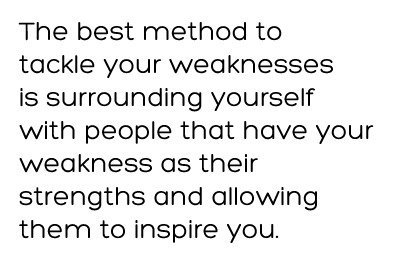
You’re in the process of becoming also a visual development artist. What does this mean? And what drew (pun surely intended) you to this discipline?

You’re in the process of becoming also a visual development artist. What does this mean? And what drew (pun surely intended) you to this discipline?
A visual development artist, to me, is an individual that works together with a team to bring a script of an animated film to life. This involves creating appealing characters and environments, as well as combining both elements to illustrate emotional “moments” from the script that will ultimately help define what the film will look like.
My love for visual development began while watching Ghibli Movies for the first time when I was a kid. Hayao Miyazaki, co-founder and director of Studio Ghibli, has always been my inspiration. His movies moved me in ways I never experienced before. In fact, I still remember how I felt the first time I saw “Kiki’s Delivery Service” and “Spirited Away.” Since that moment, I fell in love with animation, storytelling and “visual magic” and I’ve always dreamed to touch the life of people with my work in the same way he did to me.
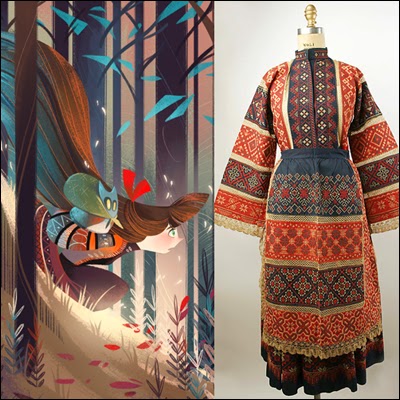
Can you give a tour of how an idea, for illustration/character design, gets real? For example, what were the steps and tools used to materialize your “Magic Forest” composition (above)?
My love for visual development began while watching Ghibli Movies for the first time when I was a kid. Hayao Miyazaki, co-founder and director of Studio Ghibli, has always been my inspiration. His movies moved me in ways I never experienced before. In fact, I still remember how I felt the first time I saw “Kiki’s Delivery Service” and “Spirited Away.” Since that moment, I fell in love with animation, storytelling and “visual magic” and I’ve always dreamed to touch the life of people with my work in the same way he did to me.

Can you give a tour of how an idea, for illustration/character design, gets real? For example, what were the steps and tools used to materialize your “Magic Forest” composition (above)?
“Magic Forest” began with a simple idea, which was “Color Harmonies.” I was taking a Light & Color class at the time, and the teacher gave a few tips about relationships of colors, which got me inspired, instantly.
Before starting, I did a little bit of research and found photos of a Russian outfit from the 20th century and fell in love!
After that, it was just a matter of (shamelessly) taking my artistic liberties and using complementary colors to create the kind of “feeling” I was looking for. Different colors give you different emotions. I was aiming for something “Magical” or Whimsical” and I think it worked out at the end.
Of course, the process can vary with every illustration/character, but generally everything begins with an idea or a general “feeling”, if you trust yourself and do the research, you will get there!
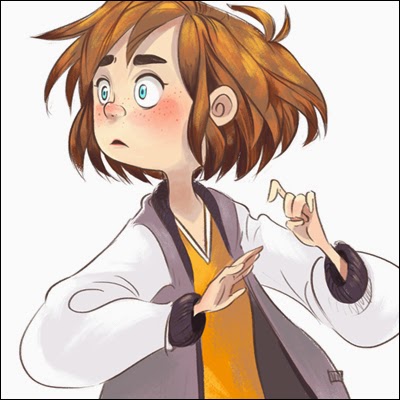
“Dani” (Digital)
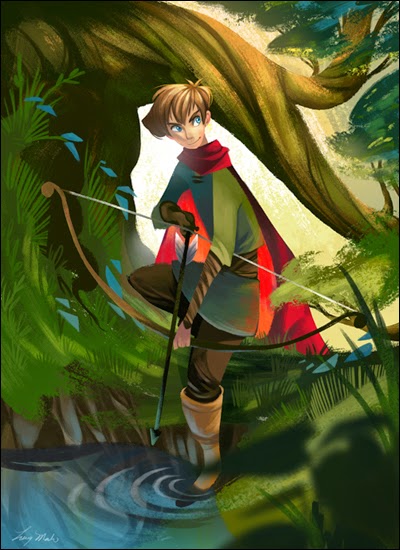
“Robin Hood” (Digital)
When I explore your work in illustration and character design, adjectives that I apply are vintage and classic, or expressed in another way, contemporary with a retro twist. What do you think about these impressions? How would you describe your visual style?
Before starting, I did a little bit of research and found photos of a Russian outfit from the 20th century and fell in love!
After that, it was just a matter of (shamelessly) taking my artistic liberties and using complementary colors to create the kind of “feeling” I was looking for. Different colors give you different emotions. I was aiming for something “Magical” or Whimsical” and I think it worked out at the end.
Of course, the process can vary with every illustration/character, but generally everything begins with an idea or a general “feeling”, if you trust yourself and do the research, you will get there!

“Dani” (Digital)

“Robin Hood” (Digital)
When I explore your work in illustration and character design, adjectives that I apply are vintage and classic, or expressed in another way, contemporary with a retro twist. What do you think about these impressions? How would you describe your visual style?
Even though I absolutely love when people associate my work with a “retro/vintage vibe”, I personally can’t define my work within a specific style, because I honestly have no idea what kind of style I have.
I’m always changing. My work changes constantly with my mood, and I’m always trying new things. Sometimes it is really hard for me to stay consistent.
I had a teacher once who said that “we are the result of the people that inspire us,” meaning we will always carry a little bit of someone else within our work. I absolutely love that. I think this relates to why my work changes so much at some degree. And as long as I put a little bit of myself in there too, I think I will be okay!
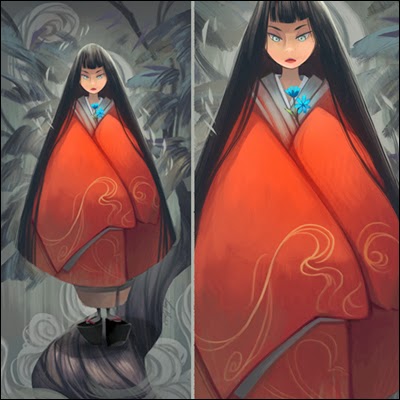
“Blue Flower” (Digital)
How do you practice drawing and coloring in order to feel competent and confident at realizing these skills?
I’m always changing. My work changes constantly with my mood, and I’m always trying new things. Sometimes it is really hard for me to stay consistent.
I had a teacher once who said that “we are the result of the people that inspire us,” meaning we will always carry a little bit of someone else within our work. I absolutely love that. I think this relates to why my work changes so much at some degree. And as long as I put a little bit of myself in there too, I think I will be okay!

“Blue Flower” (Digital)
How do you practice drawing and coloring in order to feel competent and confident at realizing these skills?
Lots of color studies, a ton of experimenting and just making sure I have fun in the process! I’m my worst critic. I think my work is very far from where I want it to be. However, I found that the best method to tackle your weaknesses is surrounding yourself with people that have your weakness as their strengths and allowing them to inspire you.
Just don’t be afraid to take a few risks and try new things. A bold move, once in a while, is good for the heart.
What is your vision of growth, as it relates to your career?
Just don’t be afraid to take a few risks and try new things. A bold move, once in a while, is good for the heart.
What is your vision of growth, as it relates to your career?
I think you realize you’ve grown as an artist when you start paying less attention to the little voice inside your head that tells you “No, you can’t do it.” Or at least it’s been the case for me. I still hear the little voice, but I’m a lot more confident that what I used to be.
In addition, relating back to a previous question, the more I feel I’ve changed or moved something inside people’s heart, the more I feel accomplished as an artist. I think art is successful when you can make people feel something with your work.
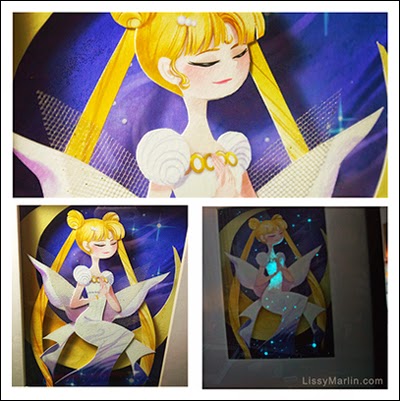
“Sailor Moon” (Cut paper)
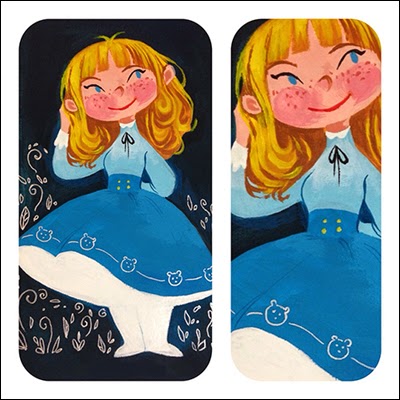
“Goldilocks” (Gouache)
I noticed, especially on your blog Doodles, that you publish your answers to questions about illustration and visual development artistry. This is a good thing that you’re doing! Can you please expand on this? What are your thoughts on learning and mentoring?
In addition, relating back to a previous question, the more I feel I’ve changed or moved something inside people’s heart, the more I feel accomplished as an artist. I think art is successful when you can make people feel something with your work.

“Sailor Moon” (Cut paper)

“Goldilocks” (Gouache)
I noticed, especially on your blog Doodles, that you publish your answers to questions about illustration and visual development artistry. This is a good thing that you’re doing! Can you please expand on this? What are your thoughts on learning and mentoring?
In my opinion, learning new skills and sharing your own knowledge helps you grow as an artist and as a person. I personally don’t know a lot of things, but I’m always up to helping those, who seek my guidance, with the best of my abilities. I will be forever grateful to those who helped me with their advice in the past, and I’m just trying to give something back by doing that. It’s my absolute pleasure.
Knowledge is power and I can’t stress it enough. One might think they know everything about the field, but there is so much more to learn out there, It’s incredible! It is really great to see how art becomes so much stronger when the artist is confident about what she or he is doing.
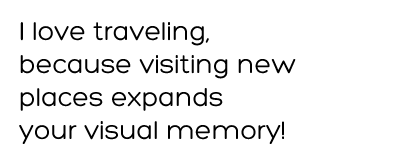
Who and/or what keep(s) you going as an illustrator and visual development artist?
On one side, the dream of seeing my work as part of something greater, like a movie, short film or a book, drives me to better myself and keep working towards that goal.
And on the other hand, I have the support and love of people around me. I make sure to work extra hard to not disappoint them, including myself.
How do you get the word out about what you do? How do you attract people to your work, whether they are art enthusiasts and/or customers?
Knowledge is power and I can’t stress it enough. One might think they know everything about the field, but there is so much more to learn out there, It’s incredible! It is really great to see how art becomes so much stronger when the artist is confident about what she or he is doing.

Who and/or what keep(s) you going as an illustrator and visual development artist?
On one side, the dream of seeing my work as part of something greater, like a movie, short film or a book, drives me to better myself and keep working towards that goal.
And on the other hand, I have the support and love of people around me. I make sure to work extra hard to not disappoint them, including myself.
How do you get the word out about what you do? How do you attract people to your work, whether they are art enthusiasts and/or customers?
To be honest, I’ve never been big at promoting myself. I like making friends through social media, and I love joining art communities because they serve as great inspiration. I share my art with people, and I make sure to put the best of my work out there. I think if you consistently share the work you love with the world, and you are reachable/accessible, people will come.
Like little bees attracted to pollen!
On creativity, design, working
How do you handle disagreements while you’re working?
Like little bees attracted to pollen!
On creativity, design, working
How do you handle disagreements while you’re working?
Usually when a partner or a client and I have a disagreement, we talk it out. Each party explains their point of view, and we slowly work towards a middle ground. Sometimes you have to commit a lot, but I think as long as both people have an open mind, it should go smoothly.
Was there a part of your work that was particularly trying, and how did you deal with it?
Was there a part of your work that was particularly trying, and how did you deal with it?
I think the hardest thing for me to do is create forms inside a believable space using perspective. What I did to solve this problem was to try to slowly introduce environments into my work. I watched tutorials, and I get a lot of reference materials such as books and visual aids. As a matter of fact, this is something I’m currently struggling with. I’m currently taking an “Introduction to perspective” workshop, hoping this could help.
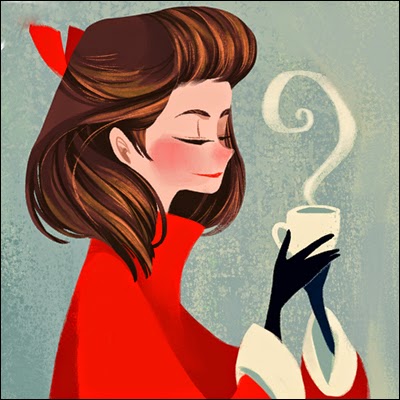
“Hot Beverage” (Digital)
What is your workspace like? How does it contribute to doing the quality of work you want to do?

“Hot Beverage” (Digital)
What is your workspace like? How does it contribute to doing the quality of work you want to do?
My workspace (below) is really simple, since I work primarily digitally, I only need a really good computer, a Wacom tablet and a comfy chair. (Oh, and a good cup of coffee!) I love surrounding myself with inspiration and pretty things, which is why I have an inspiration wall, filled with artwork next to me at all times!
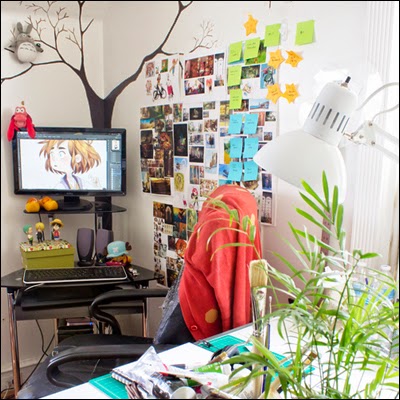
What tools do you use and recommend to work on ideas and make them grow, to collaborate and get things done?

What tools do you use and recommend to work on ideas and make them grow, to collaborate and get things done?
Every time I need to expand my ideas, I have a folder with countless amounts of art and reference stock images of people and places. Sometimes paging through this gallery can help form a more concrete image of what I want to accomplish visually. After this, I do a lot of research, I watch a few movies or hear songs that will help me stay in “the right mood”, and I tackle the white canvas the best I can.
How do you stay creative? What are some of your sources of motivation/inspiration?
How do you stay creative? What are some of your sources of motivation/inspiration?
I always try to do personal work between projects. It’s a really good thing you can do to stay creative and take some stress off your shoulders.
I also frequent blogs like Tumblr and social places like Twitter or Facebook very regularly. There, I follow a large variety of artists who love sharing their work with everyone. It’s kind of hard to feel uninspired after seeing so many people working day and night towards their own personal career goals!
What animation-film studio, whether it’s a studio of one or a few, whose work people must experience?
I also frequent blogs like Tumblr and social places like Twitter or Facebook very regularly. There, I follow a large variety of artists who love sharing their work with everyone. It’s kind of hard to feel uninspired after seeing so many people working day and night towards their own personal career goals!
What animation-film studio, whether it’s a studio of one or a few, whose work people must experience?
Studio Ghibli is at the top of the list, followed by Disney/Pixar!
What I love about Ghibli is the raw passion, love, and sincerity they put into each film, while still conserving the traditional 2D style of animation. The paintings they use for backgrounds, the characters, and the stories—everything feels like a dream I think everybody should experience.
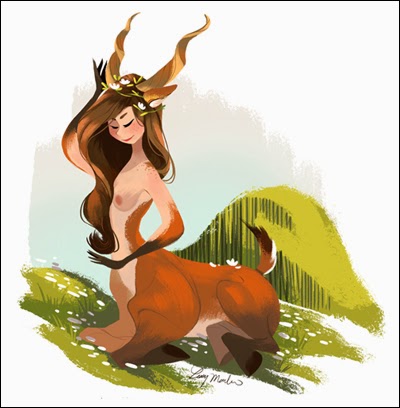
“Centaur Girl” (Digital)
How important is it for you to follow your instincts?
What I love about Ghibli is the raw passion, love, and sincerity they put into each film, while still conserving the traditional 2D style of animation. The paintings they use for backgrounds, the characters, and the stories—everything feels like a dream I think everybody should experience.

“Centaur Girl” (Digital)
How important is it for you to follow your instincts?
Following my instincts is crucial. My gut is correct 95% of the time. I think it takes a great deal of courage to follow your instincts, because we are not certain of the future, and we can’t know, for sure, if we will make good a decision. However, every time I’m encountered with a fork in the road, I trust myself with the decision that I think works best for me, and if I follow my guts, I’m sure I won’t have any regrets afterwards.
What is your definition of bad design?
What is your definition of bad design?
Something that doesn’t make you feel anything and doesn’t have a certain “flow” or harmony to it. It’s very hard to explain, but to me, a bad design is something you can tell by instinct. I’m certainly not the best at what I do, and I definitely lack the experience, but I think you can tell when something is “not right.”
If a person approached you and said, “I want to illustrate and make characters”, what's your response?
If a person approached you and said, “I want to illustrate and make characters”, what's your response?
I would be happy to hear that, especially if they were new to this. I would suggest to them a few reading materials or tutorial/classes I used to improve, and shower them with all the artists I love and admire.
I think being able to create appealing characters is such a magnificent skill. Artists put so much emotion and personality in their characters. It’s always so great to see their unique designs!
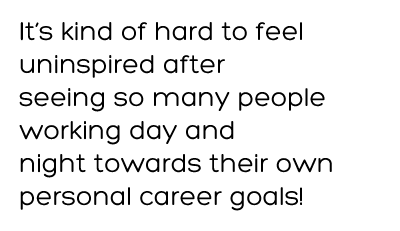
Any other aspects of you that would be interesting to creative practitioners and aspiring product/business makers?
I think being able to create appealing characters is such a magnificent skill. Artists put so much emotion and personality in their characters. It’s always so great to see their unique designs!

Any other aspects of you that would be interesting to creative practitioners and aspiring product/business makers?
I love crafting and painting. I enjoy making things with my hands, from small to big things: whether they are paintings, cut paper illustrations or wood carvings. I spend a lot of time working on digital illustrations, and creating something I can hold with my hands has become some sort of a personal ritual for me. There is something about painting/crafting that always puts me at ease and helps me come back to the creative process refreshed. I love doing it when I’m tired, at the middle of the night when everyone is asleep, with some background music and beverages. I’m often awake until dawn, but it’s just so fun and refreshing.
Since you enjoy traveling, what city contributes, in cultural ways and more, to your work?
Since you enjoy traveling, what city contributes, in cultural ways and more, to your work?
I would say every city I’ve ever visited! Also, a country I hold very dear in my heart is Japan, even though I’ve never been there (yet)
Japan has influenced my work since the beginning, to the point that I feel it is “My home away from Home.” I hope I get the opportunity to visit soon! It would be amazing!
I love traveling, because visiting new places expands your “visual memory”! You see new combinations of colors, new patterns and new people—a completely new culture! That can help you a lot at the moment of creating new worlds/environments, because the “research” is already engraved in your mind, due to your experience.
Since you’re also an active attendee of art museums, which one must people visit?
Thanks for reading so far this Design Feast interview.
To continue reading, support Design Feast on Patreon. If you’re able to, please become a Patron of Design Feast today from $1 and up—it only takes a minute. Your monthly contribution will give you full access to this interview and those upcoming with extraordinary creators and their perspectives. Stay both informed and inspired.

What will stay free to completely explore at Design Feast are the 342 insightful interviews with an incredible range of Designers, Bloggers, Makers and realizers of Side Projects.
Japan has influenced my work since the beginning, to the point that I feel it is “My home away from Home.” I hope I get the opportunity to visit soon! It would be amazing!
I love traveling, because visiting new places expands your “visual memory”! You see new combinations of colors, new patterns and new people—a completely new culture! That can help you a lot at the moment of creating new worlds/environments, because the “research” is already engraved in your mind, due to your experience.
Since you’re also an active attendee of art museums, which one must people visit?
Oh gosh, this is so hard to answer, because I can’t pick just one!
The Louvre in Paris is a must. I had the privilege of visiting, and I was nearly in tears the entire time. You would need two whole days to see everything, but if you love art history, that’s absolutely worth it.
If you find yourself in The Netherlands, you absolutely must go to the Rijksmuseum, Van Gogh Museum, and Rembrandt’s House Museum in Amsterdam—where I actually DID cry for being in the presence of so much greatness. The Prado Museum in Madrid has an exquisite collection of paintings by Francisco Goya and Diego Velázquez, which is an exhibition one must see, in person!.
Lastly, if you are in the United States and you can’t go that far, I totally recommend the Museum of Art in Philadelphia or the Metropolitan Museum of Art in New York—they are both wonderful!
• • •
All images courtesy of Lissy Marlin.
Read more from Design Feast Series of Interviews with people who love making things.
The Louvre in Paris is a must. I had the privilege of visiting, and I was nearly in tears the entire time. You would need two whole days to see everything, but if you love art history, that’s absolutely worth it.
If you find yourself in The Netherlands, you absolutely must go to the Rijksmuseum, Van Gogh Museum, and Rembrandt’s House Museum in Amsterdam—where I actually DID cry for being in the presence of so much greatness. The Prado Museum in Madrid has an exquisite collection of paintings by Francisco Goya and Diego Velázquez, which is an exhibition one must see, in person!.
Lastly, if you are in the United States and you can’t go that far, I totally recommend the Museum of Art in Philadelphia or the Metropolitan Museum of Art in New York—they are both wonderful!
• • •
All images courtesy of Lissy Marlin.
Read more from Design Feast Series of Interviews with people who love making things.
Thanks for reading so far this Design Feast interview.
To continue reading, support Design Feast on Patreon. If you’re able to, please become a Patron of Design Feast today from $1 and up—it only takes a minute. Your monthly contribution will give you full access to this interview and those upcoming with extraordinary creators and their perspectives. Stay both informed and inspired.

What will stay free to completely explore at Design Feast are the 342 insightful interviews with an incredible range of Designers, Bloggers, Makers and realizers of Side Projects.
